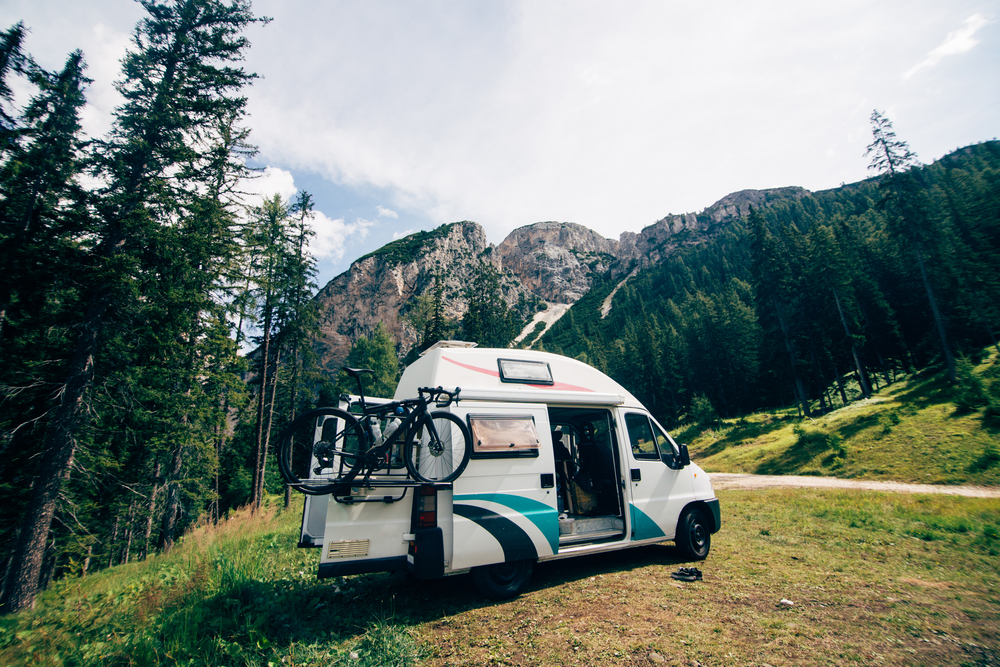Whether you’re living the #VanLife or just prefer life on the road, RV living has its perks. However, between gas, prepackaged snacks on the road, and other consumables that sometimes go along with travel, it begs the question: Is sustainable RV living even possible?
Catching the travel bug doesn’t have to mean giving up a green lifestyle. There are plenty of ways to enjoy the freedom of the open road while minimizing your environmental impact.
1. Choose an Energy-Efficient RV

RV models designed with energy efficiency in mind are a great choice for more sustainable RV living. This will not only lower your carbon footprint, but also save you money on gas. Features to look for in an energy-efficient RV include:
- Hybrid or Electric RVs: While more costly than some gas-powered counterparts, you can save money on energy in the long run by purchasing a hybrid or electric RV.
- LED lighting: These bulbs consume less energy and last longer than traditional incandescent lighting. Make sure your RV is fitted to take these bulbs.
- Efficient insulation: Good insulation keeps your RV cool in the summer and warm in the winter. A well-insulated vehicle can reduce the need for heating and cooling systems.
- Energy-efficient appliances: Use appliances that require less energy to operate, such as those with Energy Star ratings.
2. Consider Solar for Sustainable Energy
Solar panels are a game-changer for sustainable RV living. Some models even come with pre-equipped solar panels. They allow you to generate electricity from the sun, reducing your dependence on fossil fuels.
Using solar doesn’t have to be all-or-nothing, either. If you’re not ready or unable to commit to full solar panels, consider solar-powered devices to reduce your reliance on gas-powered electricity. Solar showers use heat from the sun to warm your water and are a great option if you can charge them while at camp. Smaller power banks and solar-powered flashlights can also help reduce your reliance on disposable batteries.
3. Practice Water Conservation Techniques
When considering environmentally friendly RV practices, most people think primarily of reducing gas use. However, water is also a precious natural resource. While RV living already puts you ahead on some fronts, like not keeping a lawn you have to water, you can do even more to conserve water.
When practical, installing low-flow faucets and showerheads is a great way to conserve water. These faucets can reduce water usage and are relatively inexpensive and easy to install. Depending on your toilet, you may also be able to opt for a low-flow flush mechanism.
Additionally, you should stay aware of any leaks and fix them promptly. While performing repairs on the road can be inconvenient, it will save you in the long run. Slow leaks not only waste water but can also damage your vehicle and encourage mold growth.
4. Reduce Waste

Every year, eleven million tons of plastic end up in the ocean. While you may not be able to change the world, you can certainly practice more sustainable RV living by reducing your own plastic waste.
Ways to Reduce Waste
- Use reusable containers: Single-use bags, bottles, and containers are convenient on the road, but they can take a toll on the planet.
- Use consumables more than once: Some consumables, like plastic packaging, can be challenging to avoid. If you can’t avoid using them, find ways to reuse them, like using a plastic grocery bag as a can liner.
- Recycle: Separate recyclables and dispose of them properly at designated recycling centers or facilities.
5. Adopt Sustainable Driving Habits
How you drive can significantly impact your environmental footprint. Beyond buying a more energy-efficient vehicle, you can make some changes to your driving style to improve mileage.
When possible, opt for cruise control on long stretches of highway. Cruise control helps you drive more smoothly, improving fuel efficiency. When you can’t use cruise control, or if your vehicle isn’t equipped with it, avoid rapid acceleration and harsh braking.
You can also use GPS apps like Google Maps and Waze to plot more energy-efficient routes. Plan landmarks and detours you want to visit ahead of time to save yourself from taking inefficient routes.
6. Stay Eco-Friendly
Support RV parks and campsites that prioritize sustainability by offering green amenities. Look for RV parks that provide recycling facilities so you can easily offload your recyclables. Some also may use renewable energy options.
Staying eco-friendly also means looking for sites close to areas of interest. Parking close to local entertainment and shopping means less driving to and from your day trips. Bonus points if you pick a park within walking distance of things to do!
7. Support Local and Sustainable Businesses

You can also practice sustainable RV living by supporting local sustainable businesses. Look for local businesses that focus on fresh, organic, or otherwise sustainable practices.
Farmers’ markets
Buying fresh, locally-grown produce supports sustainable agriculture practices. A large share of carbon emissions come from moving goods from where they’re produced to where they’re packaged, and again to where they’re consumed. By buying directly from farmers, you get to enjoy fresher food while reducing your carbon footprint.
Eco-friendly stores
Purchase goods from shops that prioritize environmental responsibility. Look for stores that offer bulk foods, reducing packaging. Some cities may also have “refill stations,” stores that sell products like soap and detergent by weight and allow you to fill your own bottles.
Sustainable restaurants
Dine at establishments that use locally sourced and organic ingredients. This not only cuts down on transit emissions, but also supports a thriving local economy wherever you travel.
Embrace Sustainable RV Living
By incorporating these tips into your RV lifestyle, you can enjoy the freedom of the open road while reducing your environmental footprint. Embrace the journey toward sustainable RV living and make a difference, one mile at a time.
If your sustainable travels bring you through Austin, book your stay at Austin RV Park. We’re a quick drive from plenty of local natural attractions, including state and national parks.
